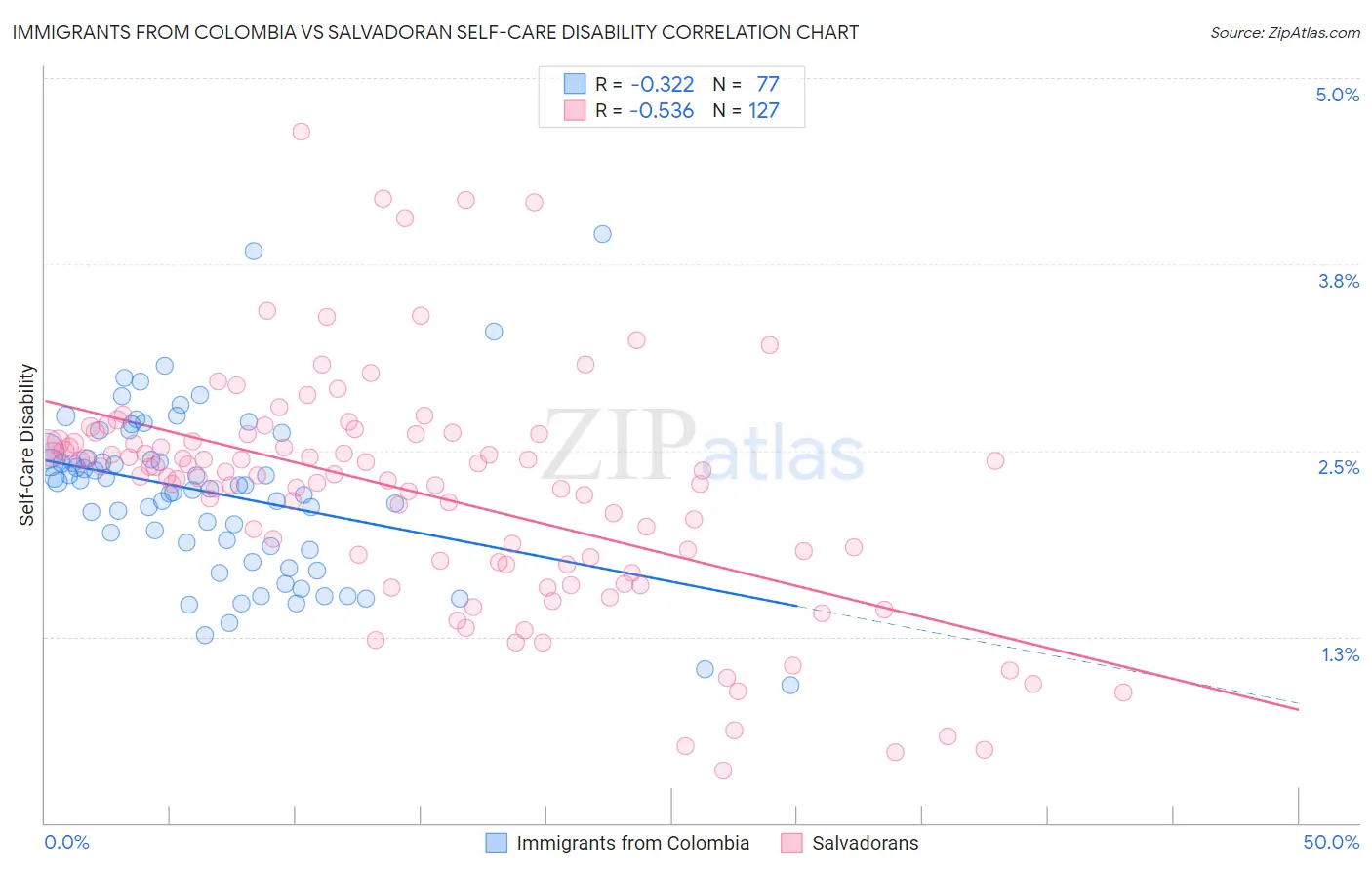Immigrants from Colombia vs Salvadoran Self-Care Disability
COMPARE
Immigrants from Colombia
Salvadoran
Self-Care Disability
Self-Care Disability Comparison
Immigrants from Colombia
Salvadorans
2.4%
SELF-CARE DISABILITY
88.5/ 100
METRIC RATING
133rd/ 347
METRIC RANK
2.5%
SELF-CARE DISABILITY
36.4/ 100
METRIC RATING
183rd/ 347
METRIC RANK
Immigrants from Colombia vs Salvadoran Self-Care Disability Correlation Chart
The statistical analysis conducted on geographies consisting of 378,342,946 people shows a mild negative correlation between the proportion of Immigrants from Colombia and percentage of population with self-care disability in the United States with a correlation coefficient (R) of -0.322 and weighted average of 2.4%. Similarly, the statistical analysis conducted on geographies consisting of 398,444,194 people shows a substantial negative correlation between the proportion of Salvadorans and percentage of population with self-care disability in the United States with a correlation coefficient (R) of -0.536 and weighted average of 2.5%, a difference of 3.2%.

Self-Care Disability Correlation Summary
| Measurement | Immigrants from Colombia | Salvadoran |
| Minimum | 0.93% | 0.35% |
| Maximum | 4.0% | 4.6% |
| Range | 3.0% | 4.3% |
| Mean | 2.2% | 2.2% |
| Median | 2.3% | 2.3% |
| Interquartile 25% (IQ1) | 1.8% | 1.8% |
| Interquartile 75% (IQ3) | 2.5% | 2.6% |
| Interquartile Range (IQR) | 0.62% | 0.81% |
| Standard Deviation (Sample) | 0.56% | 0.78% |
| Standard Deviation (Population) | 0.56% | 0.77% |
Similar Demographics by Self-Care Disability
Demographics Similar to Immigrants from Colombia by Self-Care Disability
In terms of self-care disability, the demographic groups most similar to Immigrants from Colombia are Immigrants from South America (2.4%, a difference of 0.030%), Polish (2.4%, a difference of 0.040%), Russian (2.4%, a difference of 0.040%), Immigrants from Austria (2.4%, a difference of 0.060%), and Immigrants from Romania (2.4%, a difference of 0.090%).
| Demographics | Rating | Rank | Self-Care Disability |
| Hmong | 89.9 /100 | #126 | Excellent 2.4% |
| Colombians | 89.7 /100 | #127 | Excellent 2.4% |
| Immigrants | Hungary | 89.6 /100 | #128 | Excellent 2.4% |
| Immigrants | Romania | 89.3 /100 | #129 | Excellent 2.4% |
| Immigrants | Austria | 89.0 /100 | #130 | Excellent 2.4% |
| Poles | 88.9 /100 | #131 | Excellent 2.4% |
| Immigrants | South America | 88.8 /100 | #132 | Excellent 2.4% |
| Immigrants | Colombia | 88.5 /100 | #133 | Excellent 2.4% |
| Russians | 88.2 /100 | #134 | Excellent 2.4% |
| Laotians | 87.8 /100 | #135 | Excellent 2.4% |
| South American Indians | 87.2 /100 | #136 | Excellent 2.4% |
| Austrians | 87.0 /100 | #137 | Excellent 2.4% |
| Immigrants | Croatia | 86.6 /100 | #138 | Excellent 2.4% |
| Sri Lankans | 86.6 /100 | #139 | Excellent 2.4% |
| Immigrants | Uruguay | 85.4 /100 | #140 | Excellent 2.4% |
Demographics Similar to Salvadorans by Self-Care Disability
In terms of self-care disability, the demographic groups most similar to Salvadorans are Yugoslavian (2.5%, a difference of 0.020%), Maltese (2.5%, a difference of 0.050%), Slavic (2.5%, a difference of 0.11%), Immigrants from El Salvador (2.5%, a difference of 0.18%), and Ghanaian (2.5%, a difference of 0.20%).
| Demographics | Rating | Rank | Self-Care Disability |
| Immigrants | Afghanistan | 47.6 /100 | #176 | Average 2.5% |
| Immigrants | Kazakhstan | 46.7 /100 | #177 | Average 2.5% |
| English | 46.2 /100 | #178 | Average 2.5% |
| Hungarians | 45.5 /100 | #179 | Average 2.5% |
| Indonesians | 41.2 /100 | #180 | Average 2.5% |
| Ghanaians | 40.4 /100 | #181 | Average 2.5% |
| Maltese | 37.5 /100 | #182 | Fair 2.5% |
| Salvadorans | 36.4 /100 | #183 | Fair 2.5% |
| Yugoslavians | 36.1 /100 | #184 | Fair 2.5% |
| Slavs | 34.3 /100 | #185 | Fair 2.5% |
| Immigrants | El Salvador | 33.0 /100 | #186 | Fair 2.5% |
| Irish | 28.7 /100 | #187 | Fair 2.5% |
| Immigrants | Oceania | 28.3 /100 | #188 | Fair 2.5% |
| Immigrants | Eastern Europe | 28.0 /100 | #189 | Fair 2.5% |
| Sioux | 24.6 /100 | #190 | Fair 2.5% |